start FIAT CROMA 2006 2.G Owner's Guide
[x] Cancel search | Manufacturer: FIAT, Model Year: 2006, Model line: CROMA, Model: FIAT CROMA 2006 2.GPages: 240, PDF Size: 7.41 MB
Page 125 of 240
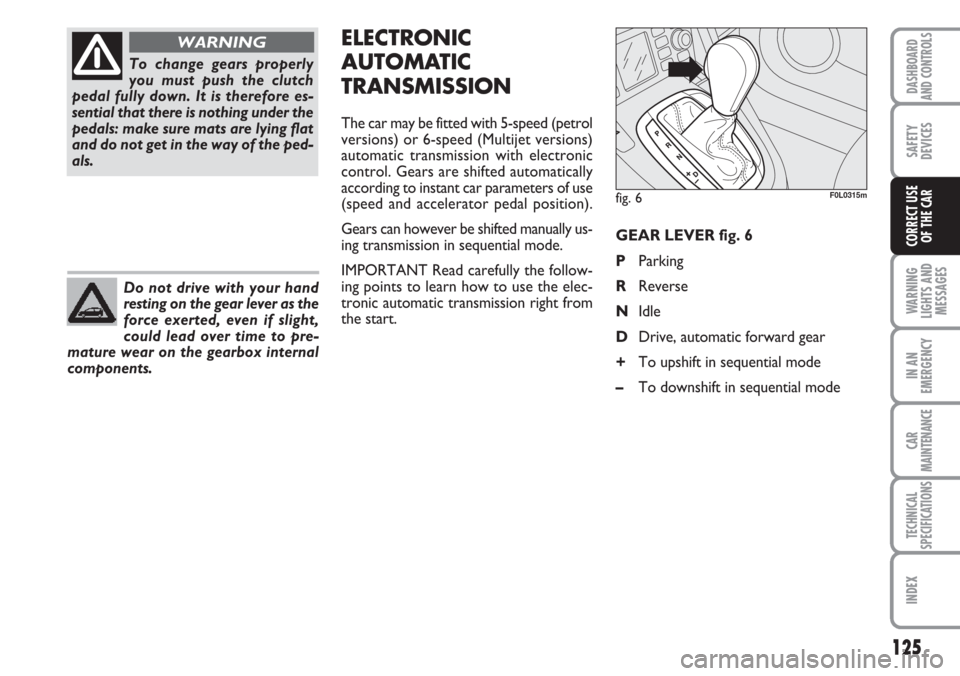
ELECTRONIC
AUTOMATIC
TRANSMISSION
The car may be fitted with 5-speed (petrol
versions) or 6-speed (Multijet versions)
automatic transmission with electronic
control. Gears are shifted automatically
according to instant car parameters of use
(speed and accelerator pedal position).
Gears can however be shifted manually us-
ing transmission in sequential mode.
IMPORTANT Read carefully the follow-
ing points to learn how to use the elec-
tronic automatic transmission right from
the start.GEAR LEVER fig. 6
PParking
RReverse
NIdle
DDrive, automatic forward gear
+To upshift in sequential mode
–To downshift in sequential mode
125
WARNING
LIGHTS AND
MESSAGES
IN AN
EMERGENCY
CAR
MAINTENANCE
TECHNICAL
SPECIFICATIONS
INDEX
DASHBOARD
AND CONTROLS
SAFETY
DEVICES
CORRECT USE
OF THE CAR
To change gears properly
you must push the clutch
pedal fully down. It is therefore es-
sential that there is nothing under the
pedals: make sure mats are lying flat
and do not get in the way of the ped-
als.
WARNING
Do not drive with your hand
resting on the gear lever as the
force exerted, even if slight,
could lead over time to pre-
mature wear on the gearbox internal
components.
fig. 6F0L0315m
Page 126 of 240
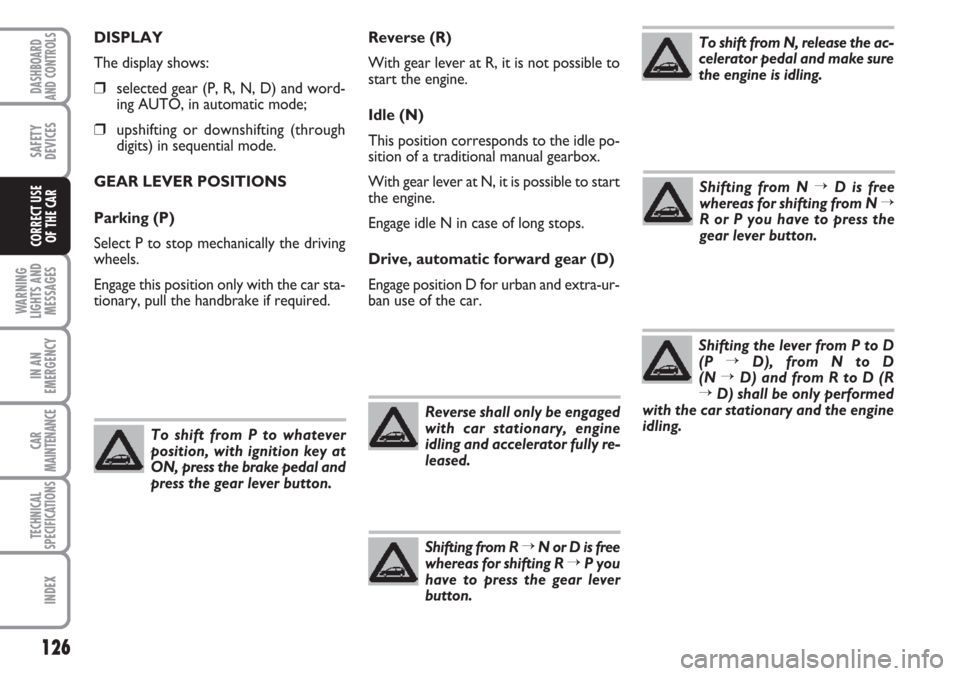
Reverse (R)
With gear lever at R, it is not possible to
start the engine.
Idle (N)
This position corresponds to the idle po-
sition of a traditional manual gearbox.
With gear lever at N, it is possible to start
the engine.
Engage idle N in case of long stops.
Drive, automatic forward gear (D)
Engage position D for urban and extra-ur-
ban use of the car. DISPLAY
The display shows:
❒selected gear (P, R, N, D) and word-
ing AUTO, in automatic mode;
❒upshifting or downshifting (through
digits) in sequential mode.
GEAR LEVER POSITIONS
Parking (P)
Select P to stop mechanically the driving
wheels.
Engage this position only with the car sta-
tionary, pull the handbrake if required.
126
WARNING
LIGHTS AND
MESSAGES
IN AN
EMERGENCY
CAR
MAINTENANCE
TECHNICAL
SPECIFICATIONS
INDEX
DASHBOARD
AND CONTROLS
SAFETY
DEVICES
CORRECT USE
OF THE CAR
To shift from P to whatever
position, with ignition key at
ON, press the brake pedal and
press the gear lever button.
Reverse shall only be engaged
with car stationary, engine
idling and accelerator fully re-
leased.
Shifting from R →N or D is free
whereas for shifting R →P you
have to press the gear lever
button.
To shift from N, release the ac-
celerator pedal and make sure
the engine is idling.
Shifting from N →D is free
whereas for shifting from N →R or P you have to press the
gear lever button.
Shifting the lever from P to D
(P →D), from N to D
(N →D) and from R to D (R→D) shall be only performed
with the car stationary and the engine
idling.
Page 127 of 240

Proceed as follows:
❒Set gear lever to N and press the
brake pedal
❒Restart the engine by turning the
key to START and set the gear
lever to D.IMPORTANT: Take the utmost care in
the following conditions: handbrake and
brake pedal released with engine idling and
gear lever at D, R or sequential since the
car can move also without pressing the ac-
celerator pedal.
The above condition can be used for park-
ing in narrow spaces, taking care to op-
erate the brake pedal only. ENGINE STARTING
❒Handbrake engaged and gear lever at
P or N: engine can be only started with
the gear lever in one of these posi-
tions.
❒With lever at P press the brake pedal
and turn the ignition key to START
without pressing the accelerator ped-
al.
❒With lever at N press the brake ped-
al and turn the ignition key to START
without pressing the accelerator ped-
al.
If the engine fails to start at first attempt,
turn the key to OFFbefore trying to
restart.
IMPORTANT With engine off, never leave
the ignition key at ONto prevent drain-
ing the battery.
IMPORTANT: if when travelling
with gear lever at D or in sequential
mode you turn inadvertently the key
to OFF the engine will turn off and
transmission will fail.
127
WARNING
LIGHTS AND
MESSAGES
IN AN
EMERGENCY
CAR
MAINTENANCE
TECHNICAL
SPECIFICATIONS
INDEX
DASHBOARD
AND CONTROLS
SAFETY
DEVICES
CORRECT USE
OF THE CARRunning the engine in con-
fined areas is extremely dan-
gerous. The engine consumes oxygen
and produces carbon monoxide
which is a highly toxic and lethal gas.
WARNING
MOVING OFF
Proceed as follows:
❒at P position, press the brake pedal;
❒press the gear lever button and move
the gear lever to the required position
(D or R);
❒accelerate gradually; the car moves off
and gearshifting will be automatic.
Never leave children unat-
tended in the car.
WARNING
Shifting from P, with ignition
key at ON, is only possible
with brake pedal pressed.
Page 128 of 240
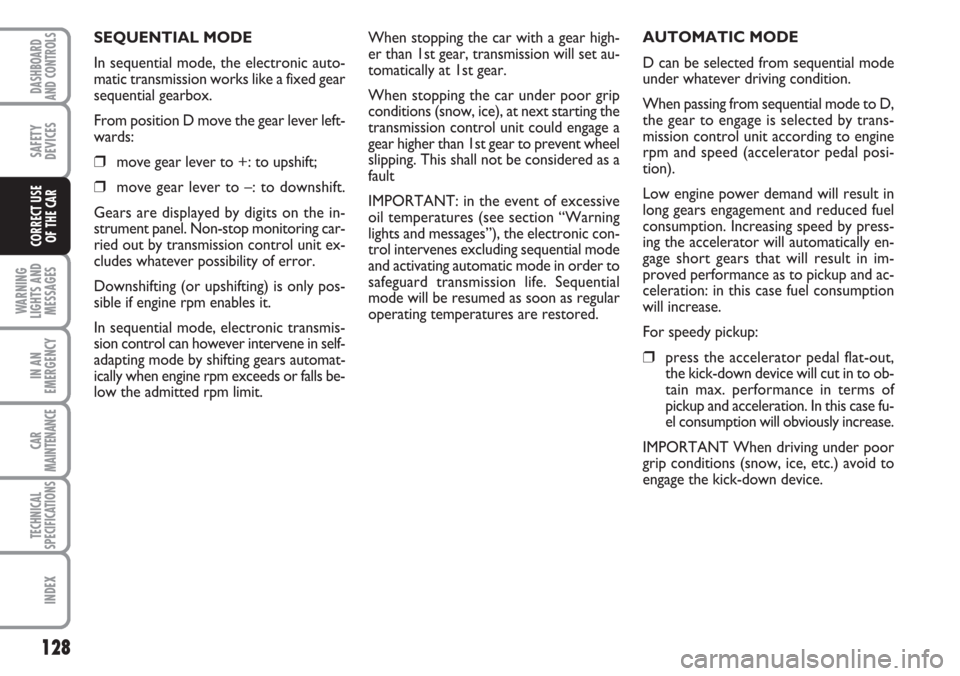
When stopping the car with a gear high-
er than 1st gear, transmission will set au-
tomatically at 1st gear.
When stopping the car under poor grip
conditions (snow, ice), at next starting the
transmission control unit could engage a
gear higher than 1st gear to prevent wheel
slipping. This shall not be considered as a
fault
IMPORTANT: in the event of excessive
oil temperatures (see section “Warning
lights and messages”), the electronic con-
trol intervenes excluding sequential mode
and activating automatic mode in order to
safeguard transmission life. Sequential
mode will be resumed as soon as regular
operating temperatures are restored.AUTOMATIC MODE
D can be selected from sequential mode
under whatever driving condition.
When passing from sequential mode to D,
the gear to engage is selected by trans-
mission control unit according to engine
rpm and speed (accelerator pedal posi-
tion).
Low engine power demand will result in
long gears engagement and reduced fuel
consumption. Increasing speed by press-
ing the accelerator will automatically en-
gage short gears that will result in im-
proved performance as to pickup and ac-
celeration: in this case fuel consumption
will increase.
For speedy pickup:
❒press the accelerator pedal flat-out,
the kick-down device will cut in to ob-
tain max. performance in terms of
pickup and acceleration. In this case fu-
el consumption will obviously increase.
IMPORTANT When driving under poor
grip conditions (snow, ice, etc.) avoid to
engage the kick-down device. SEQUENTIAL MODE
In sequential mode, the electronic auto-
matic transmission works like a fixed gear
sequential gearbox.
From position D move the gear lever left-
wards:
❒move gear lever to +: to upshift;
❒move gear lever to –: to downshift.
Gears are displayed by digits on the in-
strument panel. Non-stop monitoring car-
ried out by transmission control unit ex-
cludes whatever possibility of error.
Downshifting (or upshifting) is only pos-
sible if engine rpm enables it.
In sequential mode, electronic transmis-
sion control can however intervene in self-
adapting mode by shifting gears automat-
ically when engine rpm exceeds or falls be-
low the admitted rpm limit.
128
WARNING
LIGHTS AND
MESSAGES
IN AN
EMERGENCY
CAR
MAINTENANCE
TECHNICAL
SPECIFICATIONS
INDEX
DASHBOARD
AND CONTROLS
SAFETY
DEVICES
CORRECT USE
OF THE CAR
Page 129 of 240
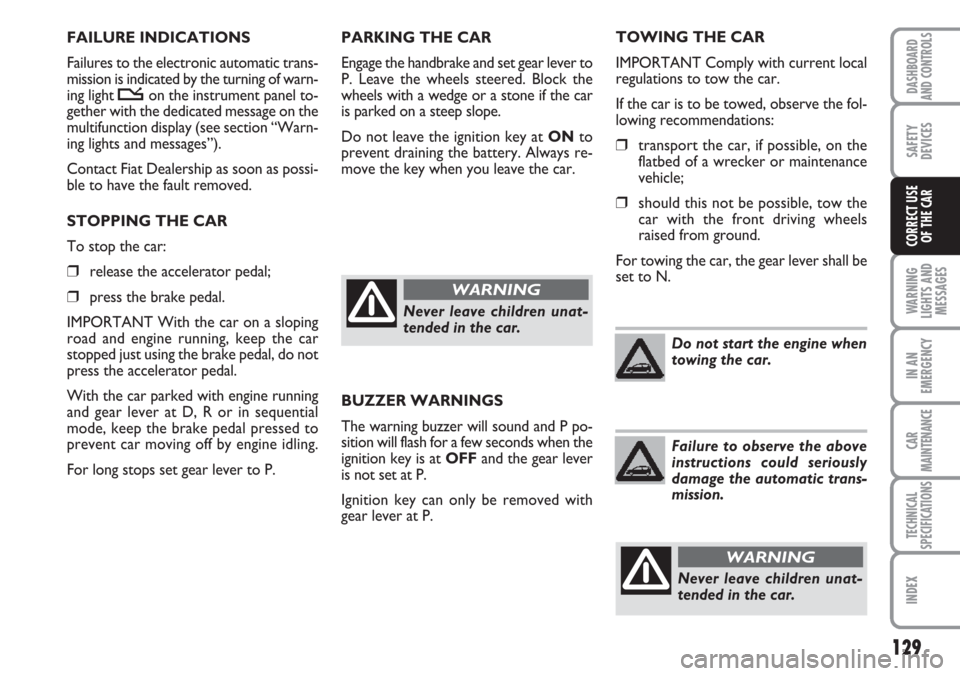
PARKING THE CAR
Engage the handbrake and set gear lever to
P. Leave the wheels steered. Block the
wheels with a wedge or a stone if the car
is parked on a steep slope.
Do not leave the ignition key at ONto
prevent draining the battery. Always re-
move the key when you leave the car.TOWING THE CAR
IMPORTANT Comply with current local
regulations to tow the car.
If the car is to be towed, observe the fol-
lowing recommendations:
❒transport the car, if possible, on the
flatbed of a wrecker or maintenance
vehicle;
❒should this not be possible, tow the
car with the front driving wheels
raised from ground.
For towing the car, the gear lever shall be
set to N. FAILURE INDICATIONS
Failures to the electronic automatic trans-
mission is indicated by the turning of warn-
ing light
ton the instrument panel to-
gether with the dedicated message on the
multifunction display (see section “Warn-
ing lights and messages”).
Contact Fiat Dealership as soon as possi-
ble to have the fault removed.
STOPPING THE CAR
To stop the car:
❒release the accelerator pedal;
❒press the brake pedal.
IMPORTANT With the car on a sloping
road and engine running, keep the car
stopped just using the brake pedal, do not
press the accelerator pedal.
With the car parked with engine running
and gear lever at D, R or in sequential
mode, keep the brake pedal pressed to
prevent car moving off by engine idling.
For long stops set gear lever to P.
129
WARNING
LIGHTS AND
MESSAGES
IN AN
EMERGENCY
CAR
MAINTENANCE
TECHNICAL
SPECIFICATIONS
INDEX
DASHBOARD
AND CONTROLS
SAFETY
DEVICES
CORRECT USE
OF THE CAR
Never leave children unat-
tended in the car.
WARNING
BUZZER WARNINGS
The warning buzzer will sound and P po-
sition will flash for a few seconds when the
ignition key is at OFFand the gear lever
is not set at P.
Ignition key can only be removed with
gear lever at P.Do not start the engine when
towing the car.
Failure to observe the above
instructions could seriously
damage the automatic trans-
mission.
Never leave children unat-
tended in the car.
WARNING
Page 130 of 240
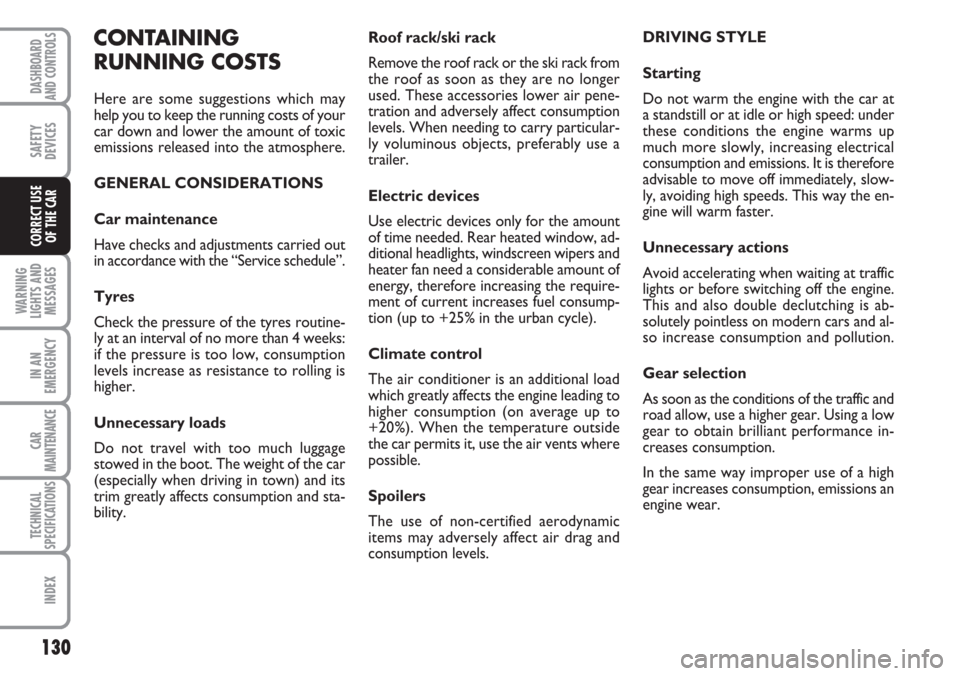
Roof rack/ski rack
Remove the roof rack or the ski rack from
the roof as soon as they are no longer
used. These accessories lower air pene-
tration and adversely affect consumption
levels. When needing to carry particular-
ly voluminous objects, preferably use a
trailer.
Electric devices
Use electric devices only for the amount
of time needed. Rear heated window, ad-
ditional headlights, windscreen wipers and
heater fan need a considerable amount of
energy, therefore increasing the require-
ment of current increases fuel consump-
tion (up to +25% in the urban cycle).
Climate control
The air conditioner is an additional load
which greatly affects the engine leading to
higher consumption (on average up to
+20%). When the temperature outside
the car permits it, use the air vents where
possible.
Spoilers
The use of non-certified aerodynamic
items may adversely affect air drag and
consumption levels.DRIVING STYLE
Starting
Do not warm the engine with the car at
a standstill or at idle or high speed: under
these conditions the engine warms up
much more slowly, increasing electrical
consumption and emissions. It is therefore
advisable to move off immediately, slow-
ly, avoiding high speeds. This way the en-
gine will warm faster.
Unnecessary actions
Avoid accelerating when waiting at traffic
lights or before switching off the engine.
This and also double declutching is ab-
solutely pointless on modern cars and al-
so increase consumption and pollution.
Gear selection
As soon as the conditions of the traffic and
road allow, use a higher gear. Using a low
gear to obtain brilliant performance in-
creases consumption.
In the same way improper use of a high
gear increases consumption, emissions an
engine wear.CONTAINING
RUNNING COSTS
Here are some suggestions which may
help you to keep the running costs of your
car down and lower the amount of toxic
emissions released into the atmosphere.
GENERAL CONSIDERATIONS
Car maintenance
Have checks and adjustments carried out
in accordance with the “Service schedule”.
Tyres
Check the pressure of the tyres routine-
ly at an interval of no more than 4 weeks:
if the pressure is too low, consumption
levels increase as resistance to rolling is
higher.
Unnecessary loads
Do not travel with too much luggage
stowed in the boot. The weight of the car
(especially when driving in town) and its
trim greatly affects consumption and sta-
bility.
130
WARNING
LIGHTS AND
MESSAGES
IN AN
EMERGENCY
CAR
MAINTENANCE
TECHNICAL
SPECIFICATIONS
INDEX
DASHBOARD
AND CONTROLS
SAFETY
DEVICES
CORRECT USE
OF THE CAR
Page 131 of 240
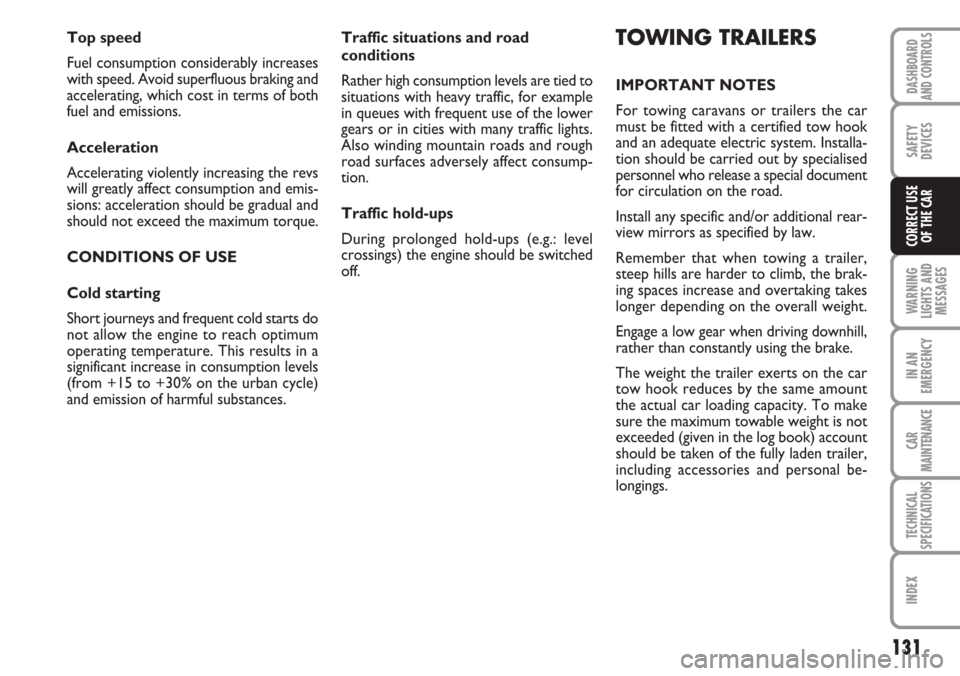
Traffic situations and road
conditions
Rather high consumption levels are tied to
situations with heavy traffic, for example
in queues with frequent use of the lower
gears or in cities with many traffic lights.
Also winding mountain roads and rough
road surfaces adversely affect consump-
tion.
Traffic hold-ups
During prolonged hold-ups (e.g.: level
crossings) the engine should be switched
off.TOWING TRAILERS
IMPORTANT NOTES
For towing caravans or trailers the car
must be fitted with a certified tow hook
and an adequate electric system. Installa-
tion should be carried out by specialised
personnel who release a special document
for circulation on the road.
Install any specific and/or additional rear-
view mirrors as specified by law.
Remember that when towing a trailer,
steep hills are harder to climb, the brak-
ing spaces increase and overtaking takes
longer depending on the overall weight.
Engage a low gear when driving downhill,
rather than constantly using the brake.
The weight the trailer exerts on the car
tow hook reduces by the same amount
the actual car loading capacity. To make
sure the maximum towable weight is not
exceeded (given in the log book) account
should be taken of the fully laden trailer,
including accessories and personal be-
longings. Top speed
Fuel consumption considerably increases
with speed. Avoid superfluous braking and
accelerating, which cost in terms of both
fuel and emissions.
Acceleration
Accelerating violently increasing the revs
will greatly affect consumption and emis-
sions: acceleration should be gradual and
should not exceed the maximum torque.
CONDITIONS OF USE
Cold starting
Short journeys and frequent cold starts do
not allow the engine to reach optimum
operating temperature. This results in a
significant increase in consumption levels
(from +15 to +30% on the urban cycle)
and emission of harmful substances.
131
WARNING
LIGHTS AND
MESSAGES
IN AN
EMERGENCY
CAR
MAINTENANCE
TECHNICAL
SPECIFICATIONS
INDEX
DASHBOARD
AND CONTROLS
SAFETY
DEVICES
CORRECT USE
OF THE CAR
Page 137 of 240
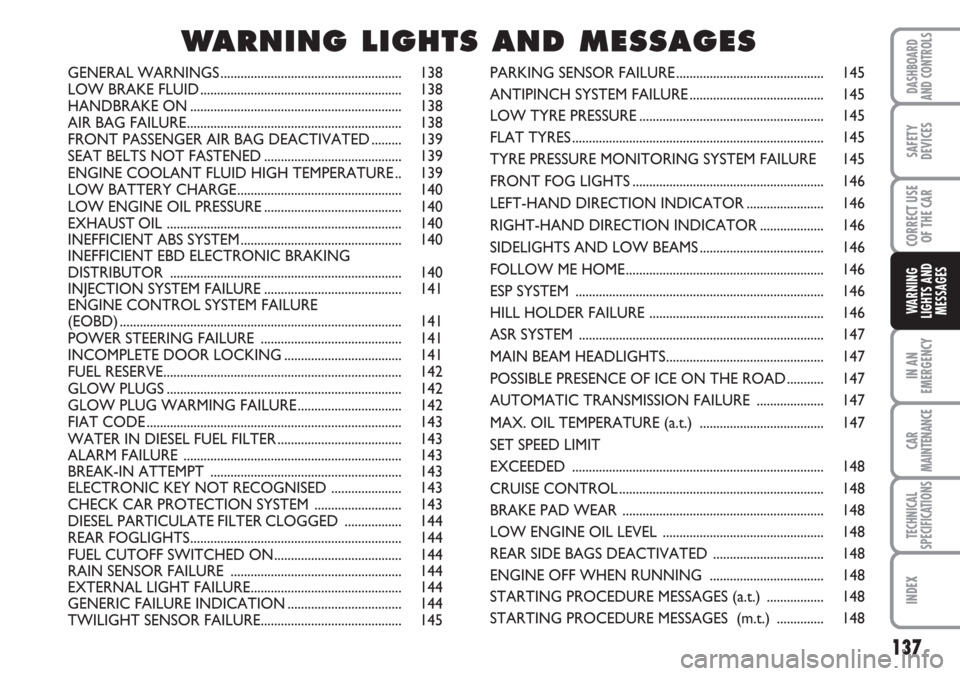
137
IN AN
EMERGENCY
CAR
MAINTENANCE
TECHNICAL
SPECIFICATIONS
INDEX
DASHBOARD
AND CONTROLS
SAFETY
DEVICES
CORRECT USE
OF THE CAR
WARNING
LIGHTS AND
MESSAGES
GENERAL WARNINGS ...................................................... 138
LOW BRAKE FLUID ............................................................ 138
HANDBRAKE ON ............................................................... 138
AIR BAG FAILURE................................................................ 138
FRONT PASSENGER AIR BAG DEACTIVATED ......... 139
SEAT BELTS NOT FASTENED ......................................... 139
ENGINE COOLANT FLUID HIGH TEMPERATURE .. 139
LOW BATTERY CHARGE................................................. 140
LOW ENGINE OIL PRESSURE ......................................... 140
EXHAUST OIL ...................................................................... 140
INEFFICIENT ABS SYSTEM ................................................ 140
INEFFICIENT EBD ELECTRONIC BRAKING
DISTRIBUTOR ..................................................................... 140
INJECTION SYSTEM FAILURE ......................................... 141
ENGINE CONTROL SYSTEM FAILURE
(EOBD) .................................................................................... 141
POWER STEERING FAILURE .......................................... 141
INCOMPLETE DOOR LOCKING ................................... 141
FUEL RESERVE....................................................................... 142
GLOW PLUGS ...................................................................... 142
GLOW PLUG WARMING FAILURE ............................... 142
FIAT CODE ............................................................................ 143
WATER IN DIESEL FUEL FILTER ..................................... 143
ALARM FAILURE ................................................................. 143
BREAK-IN ATTEMPT ......................................................... 143
ELECTRONIC KEY NOT RECOGNISED ..................... 143
CHECK CAR PROTECTION SYSTEM .......................... 143
DIESEL PARTICULATE FILTER CLOGGED ................. 144
REAR FOGLIGHTS............................................................... 144
FUEL CUTOFF SWITCHED ON...................................... 144
RAIN SENSOR FAILURE ................................................... 144
EXTERNAL LIGHT FAILURE............................................. 144
GENERIC FAILURE INDICATION .................................. 144
TWILIGHT SENSOR FAILURE.......................................... 145PARKING SENSOR FAILURE ............................................ 145
ANTIPINCH SYSTEM FAILURE ........................................ 145
LOW TYRE PRESSURE ....................................................... 145
FLAT TYRES ........................................................................... 145
TYRE PRESSURE MONITORING SYSTEM FAILURE 145
FRONT FOG LIGHTS ......................................................... 146
LEFT-HAND DIRECTION INDICATOR ....................... 146
RIGHT-HAND DIRECTION INDICATOR ................... 146
SIDELIGHTS AND LOW BEAMS ..................................... 146
FOLLOW ME HOME ........................................................... 146
ESP SYSTEM .......................................................................... 146
HILL HOLDER FAILURE .................................................... 146
ASR SYSTEM ......................................................................... 147
MAIN BEAM HEADLIGHTS............................................... 147
POSSIBLE PRESENCE OF ICE ON THE ROAD ........... 147
AUTOMATIC TRANSMISSION FAILURE .................... 147
MAX. OIL TEMPERATURE (a.t.) ..................................... 147
SET SPEED LIMIT
EXCEEDED ........................................................................... 148
CRUISE CONTROL ............................................................. 148
BRAKE PAD WEAR ............................................................ 148
LOW ENGINE OIL LEVEL ................................................ 148
REAR SIDE BAGS DEACTIVATED ................................. 148
ENGINE OFF WHEN RUNNING .................................. 148
STARTING PROCEDURE MESSAGES (a.t.) ................. 148
STARTING PROCEDURE MESSAGES (m.t.) .............. 148
W W
A A
R R
N N
I I
N N
G G
L L
I I
G G
H H
T T
S S
A A
N N
D D
M M
E E
S S
S S
A A
G G
E E
S S
Page 139 of 240
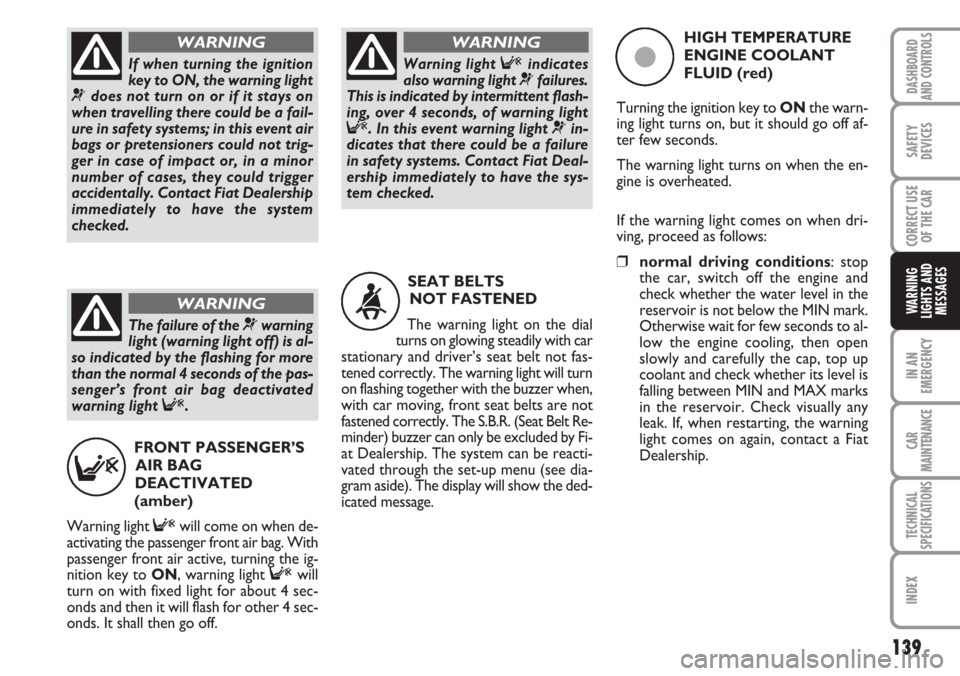
139
IN AN
EMERGENCY
CAR
MAINTENANCE
TECHNICAL
SPECIFICATIONS
INDEX
DASHBOARD
AND CONTROLS
SAFETY
DEVICES
CORRECT USE
OF THE CAR
WARNING
LIGHTS AND
MESSAGES
If when turning the ignition
key to ON, the warning light
¬does not turn on or if it stays on
when travelling there could be a fail-
ure in safety systems; in this event air
bags or pretensioners could not trig-
ger in case of impact or, in a minor
number of cases, they could trigger
accidentally. Contact Fiat Dealership
immediately to have the system
checked.
WARNING
The failure of the ¬warning
light (warning light off) is al-
so indicated by the flashing for more
than the normal 4 seconds of the pas-
senger’s front air bag deactivated
warning light
F.
WARNING
FRONT PASSENGER’S
AIR BAG
DEACTIVATED
(amber)
Warning light
Fwill come on when de-
activating the passenger front air bag. With
passenger front air active, turning the ig-
nition key to ON, warning light
Fwill
turn on with fixed light for about 4 sec-
onds and then it will flash for other 4 sec-
onds. It shall then go off.
F
Warning light Findicates
also warning light ¬failures.
This is indicated by intermittent flash-
ing, over 4 seconds, of warning light
F. In this event warning light ¬in-
dicates that there could be a failure
in safety systems. Contact Fiat Deal-
ership immediately to have the sys-
tem checked.
WARNINGHIGH TEMPERATURE
ENGINE COOLANT
FLUID (red)
Turning the ignition key to ONthe warn-
ing light turns on, but it should go off af-
ter few seconds.
The warning light turns on when the en-
gine is overheated.
If the warning light comes on when dri-
ving, proceed as follows:
❒normal driving conditions: stop
the car, switch off the engine and
check whether the water level in the
reservoir is not below the MIN mark.
Otherwise wait for few seconds to al-
low the engine cooling, then open
slowly and carefully the cap, top up
coolant and check whether its level is
falling between MIN and MAX marks
in the reservoir. Check visually any
leak. If, when restarting, the warning
light comes on again, contact a Fiat
Dealership.
ç
SEAT BELTS
NOT FASTENED
The warning light on the dial
turns on glowing steadily with car
stationary and driver’s seat belt not fas-
tened correctly. The warning light will turn
on flashing together with the buzzer when,
with car moving, front seat belts are not
fastened correctly. The S.B.R. (Seat Belt Re-
minder) buzzer can only be excluded by Fi-
at Dealership. The system can be reacti-
vated through the set-up menu (see dia-
gram aside). The display will show the ded-
icated message.
<
Page 140 of 240
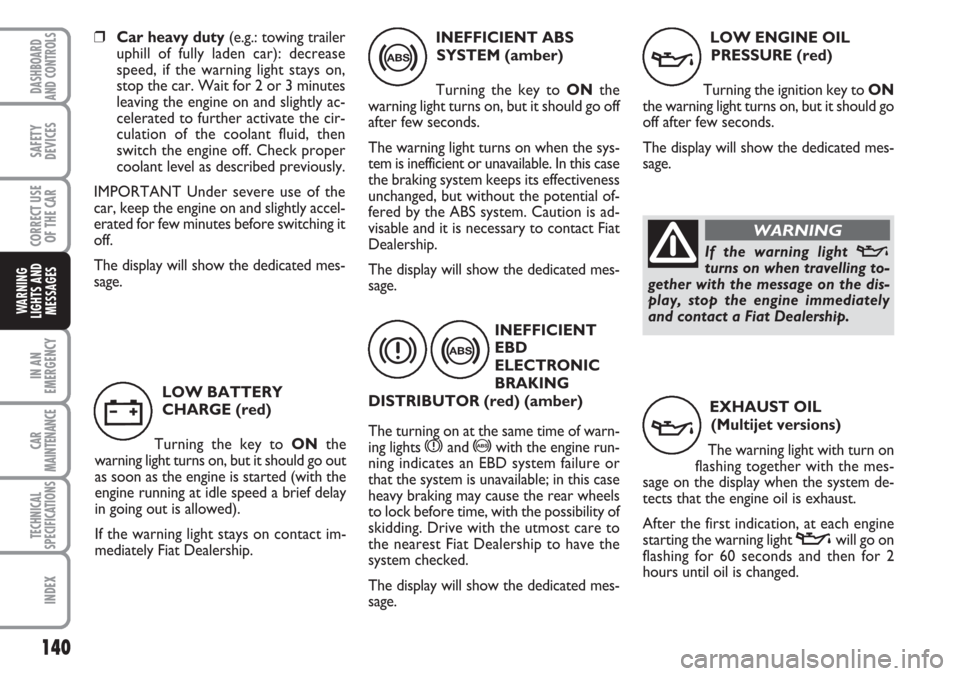
EXHAUST OIL
(Multijet versions)
The warning light with turn on
flashing together with the mes-
sage on the display when the system de-
tects that the engine oil is exhaust.
After the first indication, at each engine
starting the warning light
vwill go on
flashing for 60 seconds and then for 2
hours until oil is changed.
140
IN AN
EMERGENCY
CAR
MAINTENANCE
TECHNICAL
SPECIFICATIONS
INDEX
DASHBOARD
AND CONTROLS
SAFETY
DEVICES
CORRECT USE
OF THE CAR
WARNING
LIGHTS AND
MESSAGES
❒Car heavy duty(e.g.: towing trailer
uphill of fully laden car): decrease
speed, if the warning light stays on,
stop the car. Wait for 2 or 3 minutes
leaving the engine on and slightly ac-
celerated to further activate the cir-
culation of the coolant fluid, then
switch the engine off. Check proper
coolant level as described previously.
IMPORTANT Under severe use of the
car, keep the engine on and slightly accel-
erated for few minutes before switching it
off.
The display will show the dedicated mes-
sage.
LOW BATTERY
CHARGE (red)
Turning the key to ONthe
warning light turns on, but it should go out
as soon as the engine is started (with the
engine running at idle speed a brief delay
in going out is allowed).
If the warning light stays on contact im-
mediately Fiat Dealership.
w
INEFFICIENT ABS
SYSTEM (amber)
Turning the key to ONthe
warning light turns on, but it should go off
after few seconds.
The warning light turns on when the sys-
tem is inefficient or unavailable. In this case
the braking system keeps its effectiveness
unchanged, but without the potential of-
fered by the ABS system. Caution is ad-
visable and it is necessary to contact Fiat
Dealership.
The display will show the dedicated mes-
sage.
>
INEFFICIENT
EBD
ELECTRONIC
BRAKING
DISTRIBUTOR (red) (amber)
The turning on at the same time of warn-
ing lights
xand >with the engine run-
ning indicates an EBD system failure or
that the system is unavailable; in this case
heavy braking may cause the rear wheels
to lock before time, with the possibility of
skidding. Drive with the utmost care to
the nearest Fiat Dealership to have the
system checked.
The display will show the dedicated mes-
sage.
x>
LOW ENGINE OIL
PRESSURE (red)
Turning the ignition key to ON
the warning light turns on, but it should go
off after few seconds.
The display will show the dedicated mes-
sage.
v
v
If the warning light vturns on when travelling to-
gether with the message on the dis-
play, stop the engine immediately
and contact a Fiat Dealership.
WARNING